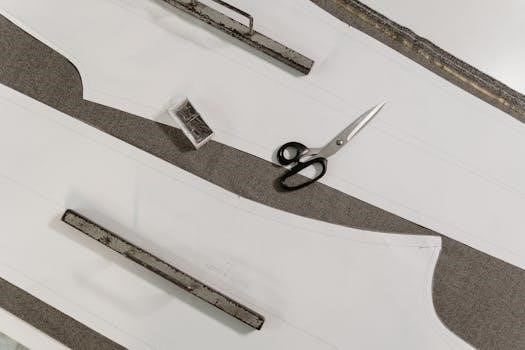Finding the right shirt size can be challenging due to variations in sizing across brands and regions. Accurate shirt measurements are essential for a comfortable and well-fitting garment, impacting both appearance and confidence.
Why Accurate Shirt Measurements Matter
Accurate shirt measurements are crucial because they directly impact comfort and appearance. A shirt that’s too tight restricts movement and can be uncomfortable, while one that’s too loose looks sloppy and ill-fitting. Proper measurements ensure that the shirt drapes correctly, enhancing your silhouette. Ill-fitting shirts can also hinder professional impressions, impacting confidence in social and work environments. Moreover, consistent and accurate measurements aid in online shopping, minimizing returns and disappointments. Understanding your measurements helps navigate different brands and their sizing variations. Ultimately, precise measurements result in a better fit, which in turn, leads to greater comfort and style.

Essential Body Measurements for Shirts
To achieve a perfect shirt fit, key body measurements are needed. These typically include neck, chest, sleeve length, and waist measurements, ensuring the shirt fits comfortably and looks tailored.
Neck Measurement⁚ Finding Your Collar Size
Accurately measuring your neck is crucial for a comfortable shirt collar. Use a flexible measuring tape, placing it around the base of your neck, where a shirt collar would naturally sit. Keep the tape level and ensure there’s a one or two-finger gap for comfort; avoid making it too tight. Round up to the nearest half-inch to determine your correct collar size. This measurement dictates the tightness of the collar and should allow for comfortable breathing and movement without feeling constricted. This is a fundamental measurement for dress shirts and button-downs.
Chest Measurement⁚ Measuring the Fullest Part
To measure your chest accurately for shirt sizing, use a flexible measuring tape. Wrap the tape around the fullest part of your chest, usually right under your armpits. Ensure the tape is level all the way around your body and that it’s not too tight. The tape should sit comfortably, without digging into your skin, but should also not be so loose that it’s sagging. This measurement is essential because it determines the overall fit of the shirt across the chest and shoulders, and ensures comfortable movement without feeling restricted or too baggy. It is often the primary factor in determining your size.
Sleeve Length⁚ From Shoulder to Wrist
Measuring sleeve length correctly is crucial for a well-fitted shirt, whether it’s a long-sleeved dress shirt or a short-sleeved casual top. Begin the measurement at the edge of your shoulder bone, where the shoulder seam of a well-fitting shirt would typically lie. Extend the measuring tape down your arm, over the outside of your elbow, and continue to your wrist bone. It’s helpful to slightly bend your elbow when taking this measurement, to ensure the sleeve isn’t too short or restricts movement. This measurement determines where the cuff will fall on your wrist, impacting comfort and the overall look of the shirt.
Waist Measurement⁚ Finding Your Natural Waistline
To accurately measure your waist for shirt sizing, locate your natural waistline. This is typically the narrowest part of your torso, often situated above your belly button and below your rib cage. To find it, try bending slightly to one side; the crease that forms is a good indicator of your natural waist. When measuring, stand relaxed and breathe normally. Wrap the measuring tape around your waist, ensuring it’s snug but not too tight. Keep the tape parallel to the floor all the way around, and note the measurement. This is a key measurement for fitted shirts and blouses.

Understanding Shirt Size Charts
Shirt size charts are crucial tools that translate body measurements into standard shirt sizes. These charts typically list chest, waist, and sleeve lengths, helping you find your ideal fit.
How to Read a Shirt Size Chart
To effectively use a shirt size chart, first locate your measurements for chest, waist, and sometimes neck and sleeve length. These measurements are usually displayed in a table format, with sizes typically listed along one axis and corresponding measurements on another. Find the row or column that best matches your measurements. Some charts may include both inches and centimeters, so pay attention to the units. If your measurements fall between two sizes, consider your preference for a tighter or looser fit. Remember that brands may vary, so always consult the specific chart provided by the retailer.
Specific Shirt Types and Sizing
Different shirt styles, like t-shirts, dress shirts, and polo shirts, often have unique sizing considerations. Understanding these variations is crucial for choosing the correct fit for each type.
T-Shirt Sizing vs. Dress Shirt Sizing
T-shirt sizing typically focuses on chest width and length, offering a more relaxed fit. Dress shirts, conversely, incorporate neck and sleeve measurements for a tailored look. T-shirts often utilize a simpler size range (S, M, L, etc.), while dress shirts have more precise sizing (e.g., 15.5/34). Dress shirt measurements are crucial for achieving a proper fit, ensuring that the collar and sleeves align correctly. T-shirt sizing prioritizes comfort and ease of movement. When choosing between a t-shirt and a dress shirt, understanding these key sizing differences is vital for optimal fit and style, depending on the occasion and personal preference.
Polo Shirt Sizing Considerations
Polo shirt sizing often falls between T-shirt and dress shirt sizing, requiring careful consideration. While typically sized using S, M, L, etc., like T-shirts, polo shirts have a more structured fit. Key measurements include chest width and length, but the fit around the shoulders and arms is also essential. Polo shirts are designed to be more fitted than T-shirts, and a proper fit should allow for comfortable movement without being too loose or too tight. The collar of the polo shirt should sit comfortably around the neck; Always check size charts, as brand sizing can vary, to find your best fit.

Tips for Choosing the Right Shirt Size
When selecting a shirt, consider your preferred fit, be it slim or regular, as well as the fabric’s properties. Always consult size charts and reviews for accurate sizing.
Considering Fit Preference⁚ Slim vs. Regular
Understanding your fit preference is crucial when choosing a shirt. Slim fit shirts are designed to hug the body closely, offering a more tailored and modern silhouette. They often taper through the waist and chest, providing a snug fit. On the other hand, regular fit shirts offer a more relaxed and comfortable feel, with a straighter cut that doesn’t cling to the body. These are generally more forgiving and suitable for various body types. Your choice between slim and regular should align with your personal style, comfort preferences, and the occasion for which you’ll be wearing the shirt. Consider how the shirt will feel during movement and sitting to make an informed decision.
Material Matters⁚ Fabric and Fit
The fabric of a shirt significantly impacts its fit and feel. Different materials behave differently when worn. For instance, cotton tends to shrink, which may alter the original fit. This potential shrinkage should be considered when selecting your size. Fabrics with stretch, such as blends with elastane, offer greater flexibility and may feel more comfortable for some, especially in fitted styles. Conversely, stiffer fabrics like linen or certain types of cotton may hold their shape better but could feel less forgiving. Therefore, when choosing a shirt, pay close attention to the material composition as it directly influences how the shirt will drape and fit on your body and how it might change over time.

Beyond Measurements⁚ Additional Factors
Beyond taking measurements, international size differences and brand-specific sizing can affect fit. Always consult size manuals, and be aware of potential variations to ensure you get the best fit.
International Size Conversions
Navigating international shirt sizes can be complex, as sizing systems vary significantly between regions like Europe, the US, and Asia. For instance, a size large in the EU might correspond to a different size in the US. These discrepancies mean that relying solely on a familiar size can lead to ill-fitting garments when purchasing from different international brands. It’s crucial to consult size conversion charts provided by retailers to ensure accurate translations between different size systems. Understanding these variations is key to avoiding size mismatches when shopping globally, as European sizes tend to be more conservative compared to American sizing.
Brand Variability and Size Manuals
Shirt sizes can differ significantly from one brand to another, meaning that a size medium in one brand might fit differently compared to a size medium in another brand. This lack of standardization makes it essential to consult size manuals provided by each retailer. These manuals often include detailed measurements for different sizes and styles, helping you to choose the best fit. Many retailers also offer online tools or questionnaires to assist in finding your correct size. Using these resources is highly recommended, as they are designed to guide you through the brand’s specific sizing system. Always check the brand’s size chart.
